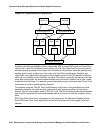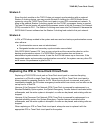
TONE-BD (Tone-Clock Circuit)
Issue 1 June 2005 2335
In addition the TN780 allows customization of up to six system tones in order to meet specific
country needs. These changes are made using the change system-parameters
country-options form.
The TN2182 allows the same International changes as the TN780 but allows the customization
of up to 24 system tones in order to meet specific country needs. These changes are made
using the change tone-generation form.
Manual Tone-Clock Interchange
In an EPN with duplicated Tone-Clock or IPSI circuit packs, one circuit pack is always preferred
over the other. For the first port network in a cabinet, this is the Tone-Clock or IPSI circuit pack
in carrier A. If a second port network is configured in a cabinet, its preferred Tone-Clock or IPSI
circuit pack is located in carrier E. The intention is that if the preferred Tone-Clock or IPSI circuit
pack has been replaced or repaired, the system will make it active by interchanging to it as soon
as possible.
In a Port Network (PN) with more than one Tone-Clock circuit pack, the intention is to assure
that the one considered most healthy is active at any given time. This is independent of the
server duplication strategy, in the sense that the active Tone-Clock circuit pack need not change
with an interchange of SPE carriers. Rather, except for the effect of the manual intervention
discussed earlier, Tone-Clock interchanges occur only as a result of changes in the health of
Tone-Clock circuit packs, as perceived by maintenance software. When both Tone-Clock circuit
packs are equally healthy, no preference is given to one over the other, regardless of which SPE
carrier is active.
It is possible to manually control Tone-Clock interchanges in three ways.
1. The standby Tone-Clock circuit pack may be made unavailable for most purposes by using
busyout tone-clock location. Such a Tone-Clock may not be selected with console
commands, nor with normal maintenance software activities, until it has been made
available again with restore tone-clock location.
Note:
Note: busyout tone-clock is not allowed for active Tone-Clock circuit packs.
2. The SPE processor lock switches may be used to force a particular SPE to be active. This
method overrides all other Tone-Clock interchange controls. If there is a Tone-Clock circuit
pack in the same carrier as the active SPE, it will become active, regardless of its health. If
the Tone-Clock circuit pack in the selected SPE was in the busyout state (see item 1
above), it will automatically be released and made active. While the lock switches are set for
a particular carrier, no manual intervention or software error detection will cause an
interchange of Tone-Clocks; the Tone-Clock circuit pack in the standby SPE carrier can
never become active. If there is no Tone-Clock circuit pack in the selected SPE at the time
the switches are set, but one is later installed, the system will interchange to it regardless of
its health. If the Tone-Clock circuit pack is removed from an SPE while the switches are set,
no interchange will occur; the system will have no active tone-clock. When the lock switches
are restored to the neutral position, a tone clock interchange will occur only if the standby
Tone-Clock circuit pack is healthier than the active one.


















